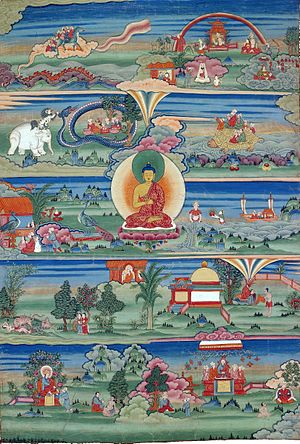Jātakamālā
Jātakamālā (T. skyes rabs 'phreng ba སྐྱེས་རབས་འཕྲེང་བ་; C. pusa benshengman 菩薩本生鬘論). "Garland of Birth Stories." A collection of 34 Jataka tales composed in Sanskrit by the Indian master Arya Shura circa the 2nd century. The text was translated into Tibetan and Chinese, and it is included in their respective canons. However, according to the Princeton Dictionary, the Chinese translators (circa 434 C.E.) had such difficulty in translating the text, that they lifted stories from other sources and matched them with the titles of Sanskrit text; hence many of the stories the Chinese translation do not match the Sansrit text or the Tibetan translation.[1]
List of stories

The Jātakamālā includes the following stories:[2]
- The Tigress
- Shibhi
- The dumpling
- The Merchant
- Avishahya, the Merchant
- The hare/rabbit
- Agastya
- Maitribala
- Vishvamtara
- The sacrifice
- Shakra
- The brahmin
- Unmadayanti
- Suparaga
- The lord of the fish
- The young quail
- The jar full of spirits
- The man without an heir
- The lotus stalks
- The royal treasurer
- Kuddhabodhi
- The king of geese
- Bodhi, the wandering ascetic
- The great ape
- The ibex
- The antelope
- The king of monkeys
- Kshantivadin
- The inhabitant of highest heaven
- The elephant
- Sutosama
- Ayogriha, the prince in the iron house
- Buffalo
- Woodpecker
Pictorial representations

At the Ajanta Caves in India, scenes from the Jātaka tales are inscribed with quotes from Arya Shura,[3] with script datable to the sixth century.
The Borobudur temple in Indonesia contains depictions of all 34 Jatakas from the Jatakamala.[4]
Modern translations
In print
- Ārya Śūra, Once the Buddha Was a Monkey, translated by Peter Khoroche, Chicago: University of Chicago Press, 1989
- Āryaśūra, The Marvelous Companion: Life Stories of the Buddha, Dharma Publishing, 1983
- Āryaśūra, Garland of the Buddha’s Past Lives, Vol. 1 & Vol. 2, translated by Justin Meiland, (Clay Sanskrit Library), NYU Press 2009
Online
Translation from a Sanskrit source text:
- Āryaśūra, Jātakamālā or Garland of Birth Stories, translated by J. S. Speyer, 1895
Note that in the Preface to this online edition, Ānandajoti Bhikkhu states:
- On the whole I think that Speyer has made a good and readable translation, but there are occasions where there are misinterpretations that will be obvious to anyone reading from a Buddhist perspective today, especially the frequent references to the Self, an interpretation which is unwarranted by the grammar or by the doctrine.
Sanskrit text
The Jātaka-Mālā of was critically edited in the original Sanskrit [Nâgarî letters] by Hendrik Kern of the University of Leiden in Netherlands, which was published as volume 1 of the Harvard Oriental Series in 1891. A second issue came in 1914.
Notes
- ↑ Buswell & Lopez 2014, s.v. Jātakamālā.
- ↑
 Jatakamala, Rigpa Shedra Wiki
Jatakamala, Rigpa Shedra Wiki
- ↑ Literary History of Sanskrit Buddhism: From Winternitz, Sylvain Levi, Huber, By Gushtaspshah K. Nariman, Moriz Winternitz, Sylvain Lévi, Edouard Huber, Motilal Banarsidass Publ., 1972 p. 44
- ↑ Jataka/Avadana Stories — Table of Contents "Archived copy". Archived from the original on 2005-12-22. Retrieved 2005-12-22.
Sources
 Buswell, Robert E.; Lopez, Donald S. (2014), The Princeton Dictionary of Buddhism, Princeton University
Buswell, Robert E.; Lopez, Donald S. (2014), The Princeton Dictionary of Buddhism, Princeton University- Hendrik Kern, The Jataka-mala: Stories of Buddha's former Incarnations (otherwise entitled Bodhisattva-Avadana-Mala) by Arya Śura, https://archive.org/details/jatakamala015656mbp
